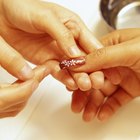
Fingernail polish protects fingernails and serves as a fashion accessory complementing a person's overall appearance and style. To prolong the life of a manicure and keep fingernail polish from peeling or cracking prematurely, apply thin coats of polish over clean nails and avoid prolonged soaking of fingernails before and after polishing.
Thick Coats
It may seem efficient to apply one or two thick coats of nail polish instead of two or three thin coats, but thin coats produce better results. When applied in thick coats, polish tends to crack and peel at the tips. Thin coats are less prone to such damage, provide better overall coverage and dry faster.
Pre-Manicure Soak
Nails absorb water better than skin does -- and they expand as they absorb it. Soaking nails before a manicure expands them, and often that water does not completely leave nails until the polish has been applied and dried. When nails contract to their original size and thickness, the polish -- which does not contract -- cracks. Either skip the soak or wait until nails have completely dried before applying polish.
Post-Manicure Soak
Soaking polished fingernails in water not only weakens the nails but also induces the same expand-and-contract situation that occurs during the pre-manicure soak. Dry nail polish does not expand or contract to accommodate the absorbent nail. As fingernails beneath the enamel first expand with moisture and then contract as that moisture evaporates, the adhesion of fingernail polish to nail surface breaks, and the polish begins to crack and peel. For best results, avoid prolonged soaking of polished nails. Use gloves when washing dishes or cleaning.
Dirt and Oils
Sometimes nail polish peels off near the cuticle because the natural oils in skin and at the base of fingernails prevent the polish from adhering to the nail's surface. To correct this, lightly buff fingernails near their cuticles before applying polish. Also scrub the nail surface free of any dirt, residues and nail file shavings, all of which might also prevent proper adhesion of the nail polish. To temporarily dehydrate the nail after wetting it, swipe a cotton ball dipped in acetone nail-polish remover across the surface.
Dry Nails
Nails and polish that are habitually dry also become brittle and prone to breaking, peeling and chipping. After the manicure, maintain a healthy amount of moisture in the nails and enamel by regularly applying nail and cuticle oils and using hand lotion.
Skipping Supportive Coats
Neglecting to apply base and top coats also leaves nail polish vulnerable to cracking and peeling. Applying a base coat provides a surface to which nail polish can cling, and a clear topcoat over the nail polish acts as a protective barrier. Some base coats also include ridge filler. However, using too much ridge filler or applying polish over a wet coat can also cause cracking. Use only one coat of base or ridge filler and allow it to dry completely before applying fingernail polish. After the manicure, regularly apply an additional layer of top coat over dried nail polish every other day to further prevent peeling and chipping.
Texturizing Topcoat
Some novelty fingernail polish topcoats are intended to crack as they dry, revealing hints of the color of nail polish applied beneath it. Available most recently in opaque black, the trend first became popular in 2000 and made a comeback in 2010 as a form of nail art. A thin coat of the crackling polish tends to crack more, producing smaller slivers of the top coat and revealing the base coat through slender but more frequent cracks. For larger patches of the topcoat and larger cracks, paint a thick coat of the crackling nail polish.
Related Articles

Cures for Acetone Damaged Nails

Clear Nail Polish vs. Top Coat

How to Treat a Cracked Nail

How to Get Acrylic Nails Off at Home ...

How to Apply Nail Polish Without Streaks

Differences Between Top Coats & Base ...

How to Make Nails Look Better After ...

How to Protect Nail Polish While You ...

How to Change Polish on Acrylic Nails

How to Treat Dry Nails

The Best Products for Thin Peeling ...

How to Repair Damaged Nails

How to Paint Nails Light Pink

If You Soak Your Nails in Water Will ...

Can Sweet Almond Oil Be Used to Soften ...

How to Do Gel Nails at Home (Like ...

Shoe Polish vs. Waterproof Spray

How to Do Fading Nail Polish

How to Make Nails Thicker

How Does Nail Polish Protect ...
References
Writer Bio
A native Midwesterner, Kristie Bishopp has been writing professionally since 1992. She started out as a technical writer and editor for a newsletter firm, then wrote several novels published under various pen names. Bishopp holds bachelor's degrees in magazine journalism and English literature from the University of Missouri-Columbia.
Photo Credits
Pixland/Pixland/Getty Images